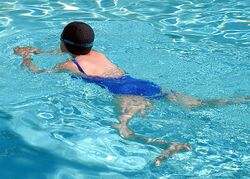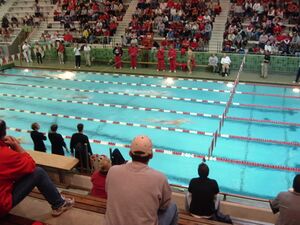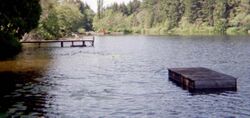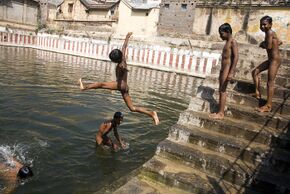Swimming: Difference between revisions
m (Robot: Automated text replacement (-\[https?://(\w{2}).wikipedia.org/wiki/(\S+) ([^]]+)] +\3)) |
|||
| Line 267: | Line 267: | ||
[[la:Natatio]] | [[la:Natatio]] | ||
[[lt:Plaukimas]] | [[lt:Plaukimas]] | ||
[[ms:Renang]] | [[ms:Renang]] | ||
[[no:Svømming]] | [[no:Svømming]] | ||
[[ug:سۇ ئۈزۈش]] | [[ug:سۇ ئۈزۈش]] | ||
| Line 286: | Line 284: | ||
[[Category:Scoutcraft]] | [[Category:Scoutcraft]] | ||
[[fi:Uinti]] | [[fi:Uinti]] | ||
Revision as of 21:01, 13 June 2021
This article concentrates on human swimming. For other species, see Ability to swim.
Swimming describes how animals and humans move themselves through water without artificial assistance.

History
Drawings from the Stone Age were found in "the cave of swimmers" near Sura in the southwestern part of Egypt. Written references date back up to 2000 B.C. In 1538 Nicolas Wynman, German professor of languages, wrote the first swimming book. Competitive swimming in Europe started around 1800, mostly using breaststroke. The front crawl, then called the trudgen was introduced in 1873 by John Arthur Trudgen, copying it from Native Americans.
Swimming was part of the first modern 1896 Summer Olympics games in Athens. In 1900 backstroke was included as an Olympic Event. In 1902 the trudgen was improved by Richard Cavill, using the flutter kick. In 1908, the world swimming association Federation Internationale de Natation was formed. Butterfly was first a variant of Breaststroke, until it was accepted as a separate style in 1952.
Technique
The human body is composed primarily of water, and thus has a very similar density to water. Roughly, 70% of the body is water; while the lungs are filled with the air, the body is slightly less dense than the surrounding water, which exerts a buoyant force on it. Thus staying afloat requires only a slight propelling of water downward relative to the body, and transverse motion only a slight propelling of water in a direction opposite to the direction of intended motion. This propelling is accomplished by using the hands and forearms as paddles, and by kicking the legs to push water away from the body (though kicking accounts for relatively little overall). Since salt water (e.g., the ocean) is denser than fresh water (e.g., most swimming pools), less effort is required to stay afloat in salt water than in fresh water.
A number of swimming styles have been developed based on the implementation of some or all of the following principles:
The torso and the legs should be kept as parallel as possible to the surface of the water. Dropped legs or a slanted torso dramatically increase drag. The hand should be extended forward of the head as much as possible. This increases the average length at the water-line, substantially increasing speed.
Recent research[citation needed] has shown that hand force applied to the water is really generated by the rotation of the hips, and not by the muscles of the arm. The muscles that pull the arm through the water are attached within one inch of the top of the arm. With a 21" arm, the lever ratio is 1:20, which means that a 100 lbs. of pull by the shoulder muscles produces only 5 lbs. of force at the hand as it pushes back against the water. The torque generated by the larger, stronger hip muscles, on the other hand, whips the hands through the water, much like golfers or batters whip their clubs and bats through the air with a fast turn of the hips. Elite swimmers who were able to make modest increases in the acceleration of their hips doubled their peak hand force output.
The time spent on the side should be maximized because so the shoulders do not break the water-line and do not produce bow waves. This reduces the frontal cross-section, reducing drag further, and also increasing the ratio between the body's water-line-length and width. Similar improvements are possible by orienting the narrowest direction of head, hands, legs and arms into the water. The torso is by far the most critical. The motion of the hand, arm, and leg from the back to the front should be in the air for as much time during the recovery stroke as possible, and in the water, oriented as hydrodynamically as possible, because the returning appendage has to move at least twice as fast as the swimmer, and in the water generates eight times the drag (which increases with the cube of the speed) of an equal amount of torso frontal area. Rotating your shoulders also adds power to one's pull by using [[[wp-en:Human|abdomen#Muscles of the abdominal wall|abdominal muscles]]] to help pull the arm through the water.
The basic "catch" of the water is not nearly as critical as the above items. Most swimmers simply grab water with their hand flat, or the fingers slightly spread, and then draw it smoothly down their body. None of the above techniques require improved strength. With strength training, the hands and feet can be extended further into the water, gaining more propulsion. For beginners, increased strength brings only small improvements if the above strategies (minimising drag and lengthening water-line) are not optimal.
Skeletal animation and computational fluid dynamics allow simulation of swimmers. This allows to quantify forces on joints and muscles, and, if multiple simulations are employed, to compare different styles or individuals. By means of computer graphics or motion capture the simulation can be compared to real swimmers. While this removes many doubts, it is still guess work needed to create new styles, it is a didactic challenge to formulate a manual for swimmers, and the feel of the water is still needed to close a control loop so that the swimming styles does not drift away afterwards (Refs with images: [1], [2], [3], [4] Fluent, Inc.: [5], [6]
Competitive swimming
The goal of competitive swimming is to be the fastest to swim a given distance. Competitive swimming became popular in the nineteenth century, and currently comprises 34 events - 17 male events and 17 female events. Swimming is a popular event at the Summer Olympic Games, where male and female athletes compete in 13 of the recognized events each. Olympic events are held in a 50meter pool. Competitive swimming's international governing body is FINA (Fédération Internationale de Natation), the International Swimming Federation.
The four competitive strokes are the butterfly, backstroke, breaststroke, and freestyle(frontcrawl). These strokes can be swum individually or together in an individual medley (IM). The IM order is: 1) butterfly, 2) backstroke, 3) breaststroke, and 4) freestyle. There are two types of relays: medley and freestyle. The medley relay order is: 1) backstroke, 2) breaststroke, 3) butterfly, and 4) freestyle. Each of the four swimmers in the relay swims a predetermined distance, dependent on the overall length of the relay. The three relay lengths are 200 meters or yards, 400 meters or yards, and 800 meters or yards (which is only swum freestyle). In a 50 meter pool, each swimmer swims one length for the 200 relay, two lengths for the 400 relay, and four lengths for the 800 relay. In a 25 meter or yard pool, each swimmer swims two lengths for the 200 relay, four lengths for the 400 relay, and eight lengths for the 800 relay. Many full-size competition pools in the United States have a length of 50 meters and a width of 25 yards, allowing both short course (25 m or 25 yd pool) and long course (50 m pool) races to be held.
There are a few types of judges: a starter sets off the swimmers; turn judges check that the swimmers' turns are within rules; swim judges check the swimmers' strokes; time keepers time the swims; and the umpire checks that everything is running smoothly. If an official catches a swimmer breaking a rule concerning the stroke he or she is swimming, that swimmer is said to be disqualified (commonly referred to as "DQ'd" or "deaked") and the swim is not considered valid.
In the United States and the United Kingdom communities may sponsor competitive swimming leagues for children and teenagers, made up of swim teams. These leagues for the most part adhere to recognized swimming rules, swim the standard strokes, but swim shorter lengths as events in swim meets. These leagues are usually active in the warmer months, and are not directly associated with a national or world swim organization. However, swimmers who begin their competitive swimming experience on such a local swim team may go on to join a nationally-governed team.
- See also List of swimmers
Recreational swimming
The most common purpose for swimming is recreation. Recreational swimming is considered by many a good way to relax, as well as providing a good full-body workout. Several swimming styles are suitable for recreational swimming; most recreational swimmers prefer a style that keeps their head out of the water and with an underwater arm recovery. Breaststroke, side stroke, and 'dog paddle', are the most common strokes utilized in recreational swimming, but the out-of-water arm recovery of freestyle or Butterfly gives rise to better exploitation of the difference in resistance between air and water.
Butterfly stroke, which consists of out-of-water recovery with even symmetry in body movements, is most suited to rough water swimming. For example, in a record-setting example of endurance swimming, Vicki Keith crossed the rough waters of Lake Ontario using butterfly. Most recreational swimming takes place in pools, where the water is calm. Therefore freestyle (which does not work as well in rough water) is suitable. Venues for recreational swimming are swimming pools, beaches, lakes, swimming holes, creeks, rivers, and sometimes canals.
Occupational swimming
Some occupations require the workers to swim. For example, abalone divers or pearl divers swim and dive to obtain an economic benefit, as do spear fishermen.
Swimming is used to rescue other swimmers in distress. There are a number of specialized swimming styles specially for rescue purposes (see List of swimming styles). Such techniques are studied by lifeguards or members of the Coast Guard. The training of these techniques has also evolved into competitions such as surf lifesaving.
Swimming is also used in marine biology to observe plants and animals in their natural habitat. Other sciences use swimming, for example Konrad Lorenz swam with geese as part of his studies of animal behavior.
Swimming also has military purposes. A swimmer in the water or under the water can be difficult to detect, especially at night. Military swimming is usually done by special forces, such as Navy SEALS. Swimming is used to approach a location, gather intelligence, sabotage or combat, and to depart a location. This may also include airborne insertion into water or leaving a submerged submarine through a hatch or the torpedo tubes.
Swimming has become a professional sport as well. Companies such as Speedo and Tyr Sports, Inc. sponsor swimmers just as Nike sponsors basketball players. Cash awards are also given at many of the major competitions for breaking records.
Swimming for exercise
Swimming is an excellent form of exercise. Because the density of the human body is approximately similar to that of water, the body is supported by the water and less stress is therefore placed on joints and bones. Therefore, swimming is frequently used as an exercise in rehabilitation after injuries or for those with disabilities.
Resistance swimming is one form of swimming exercise. It is done either for training purposes, to hold the swimmer in place for stroke analysis, or to enable swimming in a confined space for athletic or therapeutic reasons. Resistance swimming can be done either against a stream of moving water (often termed a swimming machine) or by holding the swimmer stationary with elastic attachments.
Swimming is primarily an aerobic exercise due to the long exercise time, requiring a constant oxygen supply to the muscles, except for short sprints where the muscles work anaerobically. As with most aerobic exercise it is believed to reduce the harmful effects of stress.
The risks of swimming

Swimming is generally a healthy activity and enjoys a low risk of injury compared with many other sports. Nevertheless there are some health risks with swimming, including the following:
- Drowning, inhalation arising from
- Adverse water conditions swamping or overwhelming the swimmer or causing water inhalation.
- Negative buoyancy when attached to a heavy object or entrapment e.g. in a sinking ship.
- Actions of others pushing under water accidentally in play or intentionally.
- Exhaustion or unconsciousness.
- Incapacitation through shallow water blackout, heart attacks, carotid sinus syncope or stroke.
- Adverse effects of immersion
- Secondary drowning, where inhaled salt water creates a foam in the lungs that restricts breathing.
- Salt Water Aspiration Syndrome, SWAS.
- Thermal shock after jumping into water can cause the heart to stop.
- Exostosis which is an abnormal growth in the ear canal due to the frequent, long-term splashing of water into the ear canal. (Known as Surfers' ear or Swimmers' ear)
- Exposure to chemicals
- Disinfectant Chlorine will increase the pH of the water, if uncorrected the raised pH may cause eye or skin irritations [7].
- Chlorine inhalation; breathing small quantities of chlorine gas from the water surface whilst swimming for long periods of time may have an adverse effect on the lungs, particularly for asthmatics. This problem may be resolved by using a pool with better ventilation, with an outdoor pool having the best results.
- Chlorine also has a negative cosmetic effect after repeated long exposure, turning blonde hair green and stripping brown hair of all color, turning it very light blonde. Chlorine damages the structure of hair, turning it "frizzy."
- Infection
- Water is an excellent environment for many bacteria, parasites, fungi and viruses affecting humans depending on water quality.
- Skin infections from both swimming and shower rooms can cause athlete's foot (boat bug). The easiest way to avoid this is drying the space between the toes after swimming.
- Microscopic parasites such as Cryptosporidium can be resistant to chlorine and can cause diarrheal illness when swimmers swallow pool water.
- Ear infections, otitis media, (otitis externa).
- Swimmer's own actions
- Overuse injury; competitive butterfly stroke swimmers for example may develop some back pain, including vertebral fractures in rare cases, and shoulder pain after long years of training, breaststroke swimmers may develop knee pain, and hip pain, and freestyle and backstroke swimmers may develop shoulder pain, commonly referred to as swimmer's shoulder (a form of tendonitis).
- Hyperventilation in a bid to extend underwater breath-hold times lowers blood carbon dioxide resulting in suppression of the urge to breathe and consequent loss of consciousness towards the end of the dive, see shallow water blackout for the mechanism.
- Adverse water and weather conditions
- Currents, including tides and rivers can cause exhaustion, move swimmers away from safety, or pull swimmers under water.
- Wind enhances waves and can blow a swimmer off course.
- Hypothermia, due to cold water, can cause rapid exhaustion and unconsciousness.
- Sunburn severity can be increased by reflections in the water and the lack of clothing worn during swimming. Long-term exposure to the sun contributes to risk of skin cancer.
- Objects in the water.
- Propeller damage is a major cause of accidents, either by being run over by a boat or entanglement on climbing into a boat.
- Collision with another swimmer, the pool walls, rocks or boats.
- Diving into a submerged object, or the bottom, often in turbid water.
- Snagging on underwater objects, particularly submerged branches or wrecks.
- Stepping on sharp objects such as broken glass.
- Dangerous aquatic life
- Legal pursuit
- legislation relating to the above or (for skinny diving) modesty
- infringement of ownership rights
Swimming lessons
Children are often given formal swimming lessons, which serve to develop swimming technique and confidence. Children generally do not swim independently until 4 years of age.[1]
In Sweden, Denmark and in Finland the curriculum for the fifth grade states that all children should learn how to swim as well as how to handle emergencies near water. Most commonly, children are expected to be able to swim 200 metres (220 yards) – of which at least 50 metres (55 yards) on their back – after first falling into deep water and getting their head under water. Even though about 95 percent of Swedish school children know how to swim, drowning remains the third most common cause of death among children.[2]
In both the Netherlands and Belgium swimming lessons under school time (schoolzwemmen, school swimming) are supported by the government. Most schools provide swimming lessons. There is a long tradition of swimming lessons in the Netherlands, the Dutch translation for the breaststroke swimming style is even schoolslag (school style).
In many places, swimming lessons are provided by local swimming pools, both those run by the local authority and by private leisure companies. Many schools also include swimming lessons into their Physical Education curricula, provided either in the schools' own pool, or in the nearest public pool.
In the UK, the "Top-ups scheme" calls for school children who cannot swim by the age of 11 to receive intensive daily lessons. These children who have not reached Great Britain's National Curriculum standard of swimming 25 metres by the time they leave primary school will be given a half-hour lesson every day for two weeks during term-time. [3]
In Canada there has been a call for swimming to be included in the public school curriculum. [4]
Clothing
Modesty led to the development of the swimsuit (and in Victorian times, the bathing machine).
Men's swimsuits tend to be trunks, surf or boardshorts, competition briefs, or more improvised cut-off shorts. Almost always, the upper body is left uncovered. However, in the early part of the 20th century, it was illegal for men to be topless in the USA.
Women's swimsuits are generally either one-piece swimsuits of traditional or competitive style (such as the racerback) or bikinis. Another option would be a Tankini, more conservative than a bikini but still not a one-piece.
Bodyskins are special whole body swimsuits for competitive swimming, designed to reduce skin drag. The most popular type of bodyskin is Speedo's Fastskin series, which includes many models of the suit for both men and women.(See Competitive swimwear)
Diversity
Template:Cleanup-remainder It has been noted in media such as the Wall Street Journal that some groups such as African American and other minorities in the US are underrepresented among swimmers, particularly competitive swimmers. Some research in the 1960s, since discredited as spurious and unscientific, described blacks as recently as being inherently less buoyant and disadvantaged in water, and coaches have lost their jobs over statements in support of such theories. Nonetheless, statistically, black children between 10 and 14 drown at 4.5 times the rate of white children,[who?] most likely as a result of inadequate aquatic resources in some communities, less awareness, less swim accessory marketing in some communities and a dearth of Black competitive swimmers, especially at the national level. Though a swimming requirement at some Ivy League colleges has been criticized as unfair to minorities, wwimming is a requirement in the United Kingdom higher educational system.
The issue of diversity among swimmers is spotlighted in the movie "Pride," about a recreation coach who salvages an urban pool and created athletic stars out of disadvantaged youth. [5]
References
- ↑ Injury Prevention Committee (2003). "Swimming lessons for infants and toddlers". Paediatrics & Child Health 8 (2): 113–114. http://www.cps.ca/english/statements/IP/IP03-01.htm.
- ↑ Lindmark, Ulrika. "Tillsyn av simkunnighet och förmåga att hantera nödsituationer vid vatten" (in Swedish) (PDF). http://www.skolverket.se/content/1/c4/05/26/Rapport_simtillsyn.pdf. Retrieved 2006-06-28.
- ↑ "Children unable to swim at 11 will be given top-up lessons". Telegraph Group Limited. 2006-06-14. http://www.telegraph.co.uk/news/main.jhtml?xml=/news/2006/06/14/nswim14.xml&sSheet=/news/2006/06/14/ixuknews.html. Retrieved 2006-07-12.
- ↑ "Federal minister calls for school swim lessons". CTV. 2005-07-18. http://www.ctv.ca/servlet/ArticleNews/story/CTVNews/20050718/swim_in_school_050718?s_name=&no_ads=. Retrieved 2006-06-28.
- ↑ Wall Street Journal March 20, 2007 D1 Minorities and the Swimming Gap. Health Journal by Kevein Helliker
Bibliography
- Maniscalco F., Il nuoto nel mondo greco romano, Naples 1993.
- Mehl H., Antike Schwimmkunst, Munchen 1927.
- Sprawson, Charles (2000). Haunts of the Black Masseur - The Swimmer as Hero. University of Minnesota Press. ISBN 0-8166-3539-0.
- Tarpinian, Steve (1996). The Essential Swimmer. The Lyons Press. ISBN 1-55821-386-4.
- Cox, Lynne (2005 by Harvest Books). Swimming to Antarctica: Tales of a Long-Distance Swimmer. 2005 by Harvest Books. ISBN 0-15-603130-2.
See also
- Deep Eddy Pool—Oldest swimming pool in Texas
- Diving
- Fish locomotion
- Ice swimming
- Lifeguard
- List of swimming styles
- List of Swimmers
- List of water sports
- Resistance swimming
- Skinny dipping
- Swimming at the Summer Olympics
- Swimming machine
- Swimming pool
- Total Immersion
- Buoyancy
External links
- Drowning Prevention and Water Safety Information from Seattle Children's Hospital and the Washington State Drowning Prevention Network.
- How to swim (An archaic but very interesting article from the Boy's Own Book of Outdoor Sports (early 1900s))
- Swimming Injuries and Illnesses
- Swim Sites - Swimming web directory
- Swimming and Weight Loss
- Swimmers: Body fat mystery!
- Swimming Tips and News for All Abilities
- Online swimming information for everyone
- BBC guide for learning to swim: the Front Crawl, the Breaststroke, the Backstroke, the Butterfly
- SwimBase: Independent website with Belgian (& more) competition results + ranking + analysis
af:Swem bg:Плуване ca:Natació cy:Nofio et:Ujumine el:Κολύμβηση fa:شنا gl:Natación ko:수영 hr:Plivanje id:Berenang is:Sund (hreyfing) he:שחייה la:Natatio lt:Plaukimas ms:Renang no:Svømming ug:سۇ ئۈزۈش pl:Pływanie ru:Плавание scn:Natari simple:Swim sr:Пливање sh:Plivanje tr:Yüzme vi:Bơi lội zh-yue:游水 zh:游泳


